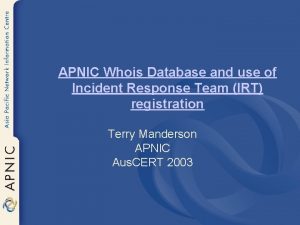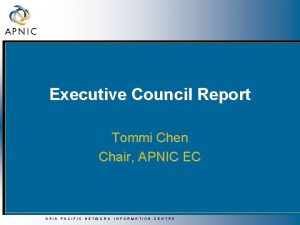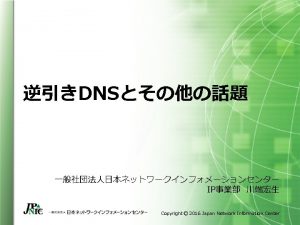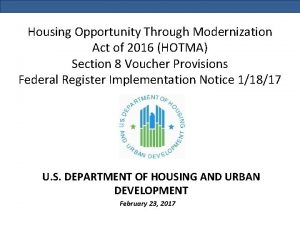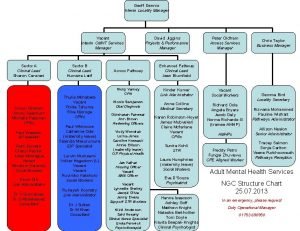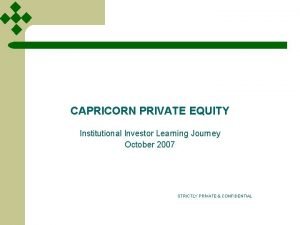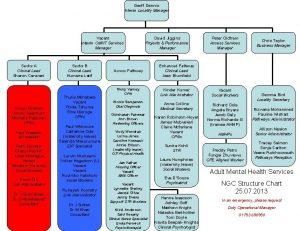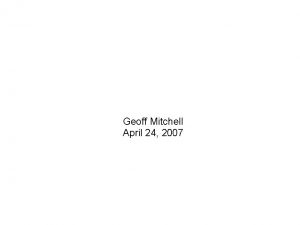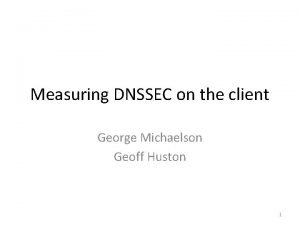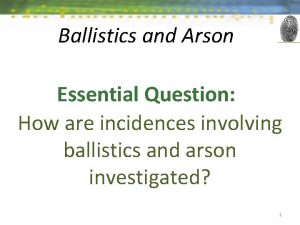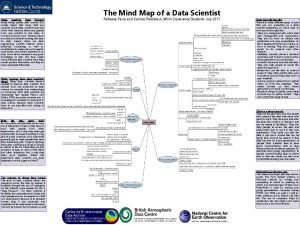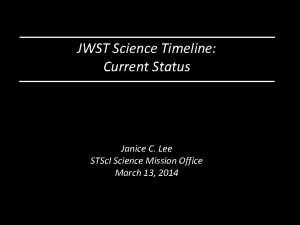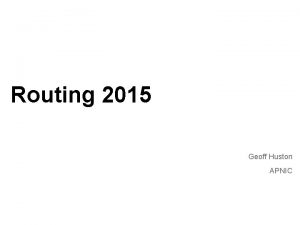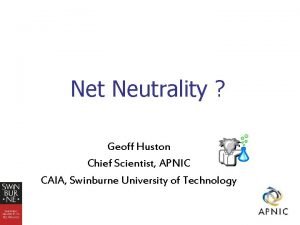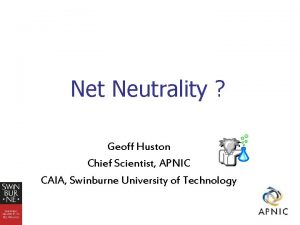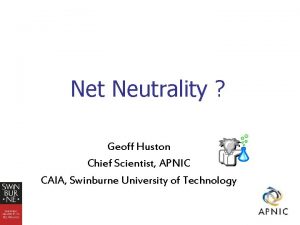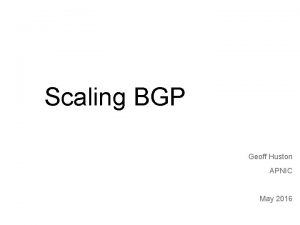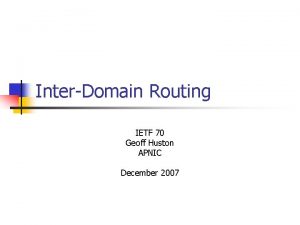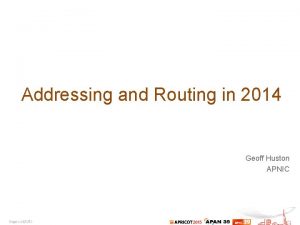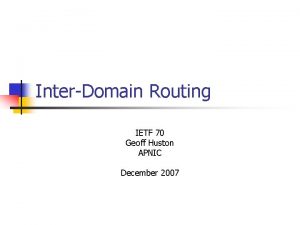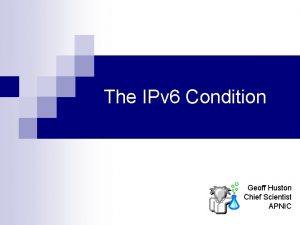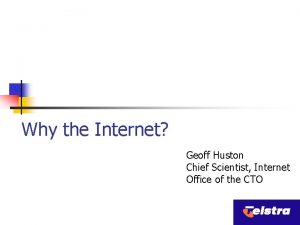Routing 2016 Geoff Huston Chief Scientist APNIC Through























































- Slides: 55

Routing 2016 Geoff Huston Chief Scientist, APNIC

Through the Routing Lens There are very few ways to assemble a single view of the entire Internet The lens of routing is one of the ways in which information relating to the entire reachable Internet is bought together Even so, its not a perfect lens…

23 Years of Routing the Internet 2011: Address Exhaustion This is a view pulled together from each of the routing peers of Route-Views 2009: The GFC hits the Internet 2005: Broadband to the Masses 2001: The Great Internet Boom and Bust 1994: Introduction of CIDR

23 Years of Routing the Internet 2011: Address Exhaustion This is a view pulled together from each of the routing peers of Route-Views 2009: The GFC hits the Internet 2005: Broadband to the Masses 2001: The Great Internet Boom and Bust 1994: Introduction of CIDR

2015 -2016 in detail

2015 -2016 in detail Route Views Peers ? ? ? average growth trend RIS Peers

October 24, 0800 UTC 4, 500 new RIB entries in 2 hours! AS net + - AS-Name AS 6327 744 0 SHAW - Shaw Communications Inc. , CA AS 9829 211 221 10 BSNL-NIB National Internet Backbone, IN AS 18881 92 92 0 TELEFONICA BRASIL S. A, BR AS 43754 80 89 9 ASIATECH, IR AS 18566 80 80 0 MEGAPATH 5 -US - Mega. Path Corporation, US AS 9116 78 79 1 GOLDENLINES-ASN 012 Smile Communications Main Autonomous System, IL AS 4800 76 1036 960 LINTASARTA-AS-AP Network Access Provider and Internet Service Provider, ID AS 38264 70 70 0 WATEEN-IMS-PK-AS-AP National Wi. MAX/IMS environment, PK AS 40676 61 85 24 AS 40676 - Psychz Networks, US AS 16322 60 61 1 PARSONLINE Tehran - IRAN, IR 7

Routing Indicators for IPv 4 Routing prefixes – growing by some 54, 000 prefixes per year AS Numbers– growing by some 3, 450 prefixes per year

Routing Indicators for IPv 4 More Specifics are still taking up one half of the routing table But the average size of a routing advertisement is getting smaller

Routing Indicators for IPv 4 Address Exhaustion is now visible in the extent of advertised address space The “shape” of inter-AS interconnection appears to be relatively steady, as the Average AS Path length has been steady through the year

AS Adjacencies (Route-Views) 19, 700 out of 57, 064 ASNs have 1 or 2 AS Adjacencies (72%) 3, 062 ASNs have 10 or more adjacencies 22 ASNs have >1, 000 adjacencies 6, 202 5, 069 4, 767 2, 632 2, 397 1, 959 1, 953 1, 691 1, 620 AS 6939 AS 174 AS 3356 AS 3549 AS 7018 AS 209 AS 57463 AS 37100 AS 34224 HURRICANE - Hurricane Electric, Inc. , US COGENT-174 - Cogent Communications, US LEVEL 3 - Level 3 Communications, Inc. , US LVLT-3549 - Level 3 Communications, Inc. , US ATT-INTERNET 4 - AT&T Services, Inc. , US CENTURYLINK-US-LEGACY-QWEST - Qwest, US NETIX , BG SEACOM-AS, MU NETERRA-AS, BG 11

What happened in 2016 in V 4? Routing Business as usual – despite IPv 4 address exhaustion! – From the look of the growth plots, its business as usual, despite the increasing pressures on IPv 4 address availability – The number of entries in the IPv 4 default-free zone is now heading to 700, 000 by the end of 2017 – The pace of growth of the routing table is still relatively constant at ~54, 000 new entries and 3, 400 new AS’s per year • IPv 4 address exhaustion is not changing this! • Instead, we are advertising shorter prefixes into the routing system

How can the IPv 4 network continue to grow when we are running out of IPv 4 addresses? We are now recycling old addresses back into the routing system Some of these addresses are transferred in ways that are recorded in the registry system, while others are being “leased” without any clear registration entry that describes the lessee

IPv 4 in 2016 – Growth is Steady • Overall IPv 4 Internet growth in terms of BGP is at a rate of some ~54, 000 entries p. a. • But we’ve run out of the unallocated address pools everywhere except Afrinic • So what’s driving this post-exhaustion growth? – Transfers? – Last /8 policies in RIPE and APNIC? – Leasing and address recovery?

IPv 4 Advertised Address “Age” 2010 2% of all new addresses announced in 2010 were >= 20 years ‘old’ (legacy) 80% of all new addresses announced in 2010 were allocated or assigned within the past 12 months

IPv 4 Advertised Address “Age” 2016 39 % of all new addresses announced in 2016 were >= 20 years ‘old’ (legacy) 24 % of all new addresses announced in 2016 were allocated or assigned within the past 12 months

IPv 4: Advertised vs Unadvertised Addresses

IPv 4: Unadvertised Addresses

IPv 4: Assigned vs Recovered Growth in Advertised Addresses RIR Allocations “draw down” “recovery” Change in the Unadvertised Address Pool

IPv 4 in 2016 The equivalent of 1. 8 /8 s was added to the routing table across 2016 • Approximately 1. 3 /8 s were assigned by RIRs in 2015 – 0. 7 /8’s assigned by Afrinic – 0. 2 /8 s were assigned by APNIC, RIPE NCC (Last /8 allocations) – 0. 1 /8 s were assigned by ARIN, LACNIC • And a net of 0. 5 /8’s were recovered from the Unadvertised Pool

The Route-Views view of IPv 6 World IPv 6 Day IANA IPv 4 Exhaustion

2015 -2016 in detail

Routing Indicators for IPv 6 Routing prefixes – growing by some 6, 000 prefixes per year AS Numbers– growing by some 1, 700 prefixes per year (which is half the V 4 growth)

Routing Indicators for IPv 6 More Specifics now take up more than one third of the routing table The average size of a routing advertisement is getting smaller

Routing Indicators for IPv 6 Advertised Address span is growing at a linear rate The “shape” of inter-AS interconnection in IPv 6 appears to be steady, as the Average AS Path length has been held steady through the year

AS Adjacencies (Route Views) 9, 105 out of 13, 197 ASNs have 1 or 2 AS Adjacencies (69%) 917 ASNs have 10 or more adjacencies 4 ASNs have >1, 000 adjacencies 3, 276 1, 607 1, 310 1, 112 AS 6939 HURRICANE - Hurricane Electric, Inc. , US AS 174 COGENT-174 - Cogent Communications, US AS 3356 LEVEL 3 - Level 3 Communications, Inc. , US AS 37100 SEACOM-AS, MU 26

IPv 6 in 2015 • Overall IPv 6 Internet growth in terms of BGP is steady at some 6, 000 route entries p. a. This is growth of BGP route objects is 1/9 of the growth rate of the IPv 4 network – as compared to the AS growth rate which is 1/2 of the IPv 4 AS number growth rate

What to expect

BGP Size Projections For the Internet this is a time of extreme uncertainty • Registry IPv 4 address run out • Uncertainty over the impacts of market-mediated movements of IPv 4 on the routing table • Uncertainty over the timing of IPv 6 takeup leads to a mixed response to IPv 6 so far, and no clear indicator of trigger points for change for those remaining IPv 4 -only networks

V 4 - Daily Growth Rates

V 4 - Daily Growth Rates

V 4 - Relative Daily Growth Rates

V 4 - Relative Daily Growth Rates Growth in the V 4 network appears to be constant at a long term average of 120 additional routes per day, or some 45, 000 additional routes per year Given that the V 4 address supply has run out this implies further reductions in address size in routes, which in turn implies ever greater reliance on NATs Its hard to see how and why this situation will persist at its current levels over the coming 5 year horizon

V 4 - Relative Daily Growth Rates Growth in the V 4 network appears to be constant at a long term average of 150 additional routes per day, or some 54, 000 additional routes per year Given that the V 4 address supply has run out this implies further reductions in address size in routes, which in turn implies ever greater reliance on NATs Its hard to see how and why this situation can persist at its current levels over the coming 5 year horizon

IPv 4 BGP Table Size Predictions Jan 2017 PREDICTION Jan 2013 2014 2015 2016 2017 2018 2019 2020 2021 2022 441, 000 488, 000 530, 000 586, 000 646, 000 700, 000 754, 000 808, 000 862, 000 916, 000 Jan 2016 PREDICTION 628, 000 675, 000 722, 000 768, 000 815, 000 Jan 2015 PREDICTION 580, 000 620, 000 670, 000 710, 000 760, 000 These numbers are dubious due to uncertainties introduced by IPv 4 address exhaustion pressures.

V 6 - Daily Growth Rates

V 6 - Relative Growth Rates

V 6 - Relative Growth Rates Growth in the V 6 network appears to be increasing, but in relative terms this is slowing down. Early adopters, who have tended to be the V 4 transit providers, have already received IPv 6 allocation and are routing them. The trailing edge of IPv 6 adoption are generally composed of stub edge networks in IPv 4. Many of these networks appear not to have made any visible moves in IPv 6 as yet. If we see a change in this picture the growth trend will likely be exponential. But its not clear when such a tipping point will occur

IPv 6 BGP Table Size predictions Exponential Model Jan 2014 16, 100 2015 21, 200 2016 27, 000 2017 35, 000 Linear Model 2018 50, 000 43, 000 2019 65, 000 51, 000 2020 86, 000 59, 000 2021 67, 000 113, 000 2022 150, 000 75, 000 Range of potential outcomes

BGP Table Growth Nothing in these figures suggests that there is cause for urgent alarm -- at present – The overall e. BGP growth rates for IPv 4 are holding at a modest level, and the IPv 6 table, although it is growing at a faster relative rate, is still small in size in absolute terms – As long as we are prepared to live within the technical constraints of the current routing paradigm, the Internet’s use of BGP will continue to be viable for some time yet – Nothing is melting in terms of the size of the routing table as yet

BGP Updates • What about the level of updates in BGP? • Let’s look at the update load from a single e. BGP feed in a DFZ context

IPv 4 Announcements and Withdrawals

IPv 4 Announcements and Withdrawals

IPv 4 Convergence Performance

Updates in IPv 4 BGP Nothing in these figures is cause for any great level of concern … – The number of updates per instability event has been relatively constant, which for a distance vector routing protocol is weird, and completely unanticipated. Distance Vector routing protocols should get noisier as the population of protocol speakers increases, and the increase should be multiplicative. – But this is not happening in the Internet – Which is good, but why is this not happening? Likely contributors to this outcome are the damping effect of widespread use of the MRAI interval by e. BGP speakers, and the topology factor, as seen in the relatively constant V 4 AS Path Length

V 6 Announcements and Withdrawals

V 6 Convergence Performance High noise components in IPv 6

V 6 Updated prefixes per day

V 6 Updates per event

Updates in IPv 6 BGP Route Updates are very unequally distributed across the prefix set – they appear to affect a very small number of prefixes which stand out well above the average

Updates in IPv 6 The busiest 50 IPv 6 prefixes accounted for 1/2 of all BGP IPv 6 prefix updates

Compared to IPv 4 IPv 6 IPv 4

Updates in IPv 6 BGP IPv 6 routing behaviour is similar to IPv 4 behaviour: Most announced prefixes are stable all of the time And as more prefixes are announced, most of these announced prefixes are highly stable. But for a small number of prefixes we observe highly unstable behaviours that dominate IPv 6 BGP updates which appear to be more unstable (relatively) than IPv 4

The State of Routing “Mostly Harmless” The levels of growth of the tables, and the levels of growth of updates in BGP do not pose any immediate concerns The trends are predictable and steady, so network operators can plan well in advance for the capacity of routing equipment to meet their future needs But: The advanced levels of instability by a small number of networks are always annoying! How can we prevent these highly unstable prefixes? 54

That’s it! Questions ?
 Geoff huston apnic
Geoff huston apnic Chief scientist scotland
Chief scientist scotland Ballad of booker t
Ballad of booker t Pure fabrication domain model
Pure fabrication domain model Lesson 3 commander in chief and chief diplomat
Lesson 3 commander in chief and chief diplomat Static routing and dynamic routing
Static routing and dynamic routing Hydrologic routing and hydraulic routing
Hydrologic routing and hydraulic routing Clock routing
Clock routing Muskingum method
Muskingum method Apnic whois
Apnic whois Myapnic
Myapnic Apnic ec
Apnic ec Apnic dns
Apnic dns Animal anthony apnic
Animal anthony apnic Debogon project
Debogon project Housing opportunity through modernization act of 2016
Housing opportunity through modernization act of 2016 Lurvin munisami
Lurvin munisami Watchdog dad
Watchdog dad Geoff barton dundee
Geoff barton dundee Geoff cundiff
Geoff cundiff Geoff layer
Geoff layer Geoff hayward
Geoff hayward Geoff squire
Geoff squire Geoff willis
Geoff willis Geoff knowles
Geoff knowles Geoff baines
Geoff baines Geoff petty icedip
Geoff petty icedip Geoff buckley
Geoff buckley Capricorn private equity
Capricorn private equity Geoff goldsmith
Geoff goldsmith Geoff savage
Geoff savage Kavita deepak knights
Kavita deepak knights Geoff barton headteacher
Geoff barton headteacher Geoff kleinman
Geoff kleinman Skin care conclusion
Skin care conclusion Geoff hulten
Geoff hulten Romiette and julio quotes
Romiette and julio quotes Radiation safety
Radiation safety Geoff petty
Geoff petty Geoff wilson lexington ky
Geoff wilson lexington ky Geoff petty
Geoff petty Geoff mitchell md
Geoff mitchell md Geoff parks
Geoff parks Geoff hollington
Geoff hollington Geoff michaelson
Geoff michaelson Cdmhp
Cdmhp Furcation classification
Furcation classification Tangential timber conversion
Tangential timber conversion Night of the scorpion is written by
Night of the scorpion is written by By one man sin
By one man sin George catlin (political scientist)
George catlin (political scientist) Burned fire scientist questions arson
Burned fire scientist questions arson Guess the scientist
Guess the scientist Mind map data science
Mind map data science Christ the scientist
Christ the scientist Timeline jwst
Timeline jwst









